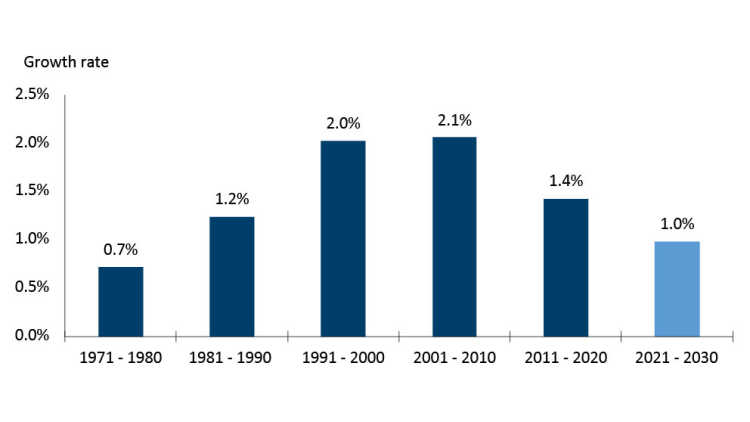Rekindling agriculture productivity growth - a $30B opportunity over ten years

Canada’s agricultural productivity growth has slowed since 2011, which is consistent with overall productivity trends around the globe. This slowdown has occurred when food security concerns are heightened and climate change disrupts food production. Innovation and technology can rekindle productivity growth going forward. Assuming the Canadian agriculture industry returns productivity growth to the plateau we recorded two decades ago, this would add as much as $30 billion in net cash income over ten years. Efforts and resources to spark innovation can boost agriculture productivity growth and enhance food security and sustainability.
A simple definition of productivity
Agricultural productivity measures the quantity of goods and services produced with a given quantity of inputs. It evaluates how inputs such as labour, capital, land, and material (fertilizer, feed, etc.) are transformed into outputs such as crops, livestock, and aquaculture products. Total factor productivity (TFP) measures the combined effects of new technologies, efficiency improvements and economies of scale.
TFP growth is achieved when producers increase their output using the same or smaller quantities of inputs. In other words, TFP growth rises when producers implement new technology or find efficiencies in how they mix and utilize fewer farm inputs to increase output. Accelerated growth in TFP growth can lead to an expansion of the food supply and boost the ratio of farm product prices to farm input prices paid by farm operators.
Sensational productivity growth, a plateau and a challenge
Between 1970 and 2020, the number of farms in Canada declined by 50%, average farm size doubled, and farm value per acre almost quadrupled. Farmers today can produce two times as much with the same level of inputs. The industry developed and introduced new crop varieties and feed additives, pioneered labour-saving technology, and leveraged data-generated insights, making us global leaders in providing safe and quality foods. Our innovative farm production practices led to stellar stewardship of our land and the environment. The Canadian population allocates one of the smallest shares of its disposable income to food purchases across the Western world.
Our success is rooted in the Canadian farms’ productivity journey. Yet, the low-hanging fruits are gone for growing our productivity. We recorded sensational increases in average annual productivity growth from 1971 to 2000, then hit a plateau for two decades when annual productivity growth averaged above 2% (Figure 1). The decline in productivity growth over the last decade, combined with an OECD-FAO projection of a further decline for the next ten years, represents a major challenge. This phenomenon is not unique to Canada but also presents us with an amazing opportunity.
Figure 1: Average annual TFP growth in Canadian agriculture by decade.

Sources: USDA database on agricultural productivity and FCC calculations
Boosting ag productivity can address multiple issues at once
According to the United Nations (UN), the world’s population is expected to reach nearly ten billion by 2050, which, coupled with income growth, will significantly lift food demand. Yet recent geopolitical events and rapid food inflation raised concerns about the ability of food suppliers to meet the needs of a growing global population.
Recent OECD-FAO research indicates that to achieve the UN goal of zero-hunger and meet the Paris Accord commitments to reduce emissions by 6% in agriculture, global agricultural productivity would have to grow by 28% over the next decade, which is about three times the expected rate of productivity growth globally.
Canada is ready to grow its prominent role in global agricultural markets. Lifting productivity at the farm level can boost Canadian exports of agriculture and food products. Innovation in production practices and technology can enhance resilience to climate change as the production risk profile of farms shifts. The world needs Canadian leadership in agriculture.
Pathways to improve productivity
The possibilities to enhance productivity growth abound. Yield improvements can come from GPS-driven precision farming machinery, improved irrigation technologies, enhanced nutrient management practices like 4Rs and disease-resistant varieties. Higher animal productivity growth can be achieved through optimized feeding, animal genetics, and herd management. Mechanization and automation at the farm level can sustain positive trends in labour productivity. Drones, robots, harvesters, and tractors can lead to minimal tillage and lower input costs. Some of these technologies have already been adopted, and broader adoption would go a long way to achieving a sustainable boost to productivity growth.
On estimating the relationship between productivity and income
The framework we used was developed by O’Donnell (2010). We leveraged the relationship between TFP and farmers’ trade terms (the farm product price index ratio to the farm input price index). An increase in TFP leads to improved trade terms, which translates into a positive change in net cash income (measured by the ratio of gross revenues over cash expenses).
The opportunity to restore productivity growth to its historical peak is computed by looking at the value of profits under this ambitious scenario relative to profits under the status quo projected trajectory. If the Canadian agriculture industry returns productivity growth to the peak recorded two decades ago, we estimate it would add as much as $30 billion in net cash income over ten years.
Let’s seize the opportunity.
Rekindling agricultural productivity growth in Canada is an amazing opportunity to boost farm income, alleviate global food security challenges and enhance sustainable farming. The Canadian ag industry’s collective leadership can be a powerful driver to achieve ambitious goals.

Senior Economist
Isaac Kwarteng is a Senior Economist at FCC, focusing on long-term economic research and forecasting to support strategy and risk. He also supports the CEO’s office with information and data requests.
Isaac joined FCC in 2023 from the Government of Saskatchewan, where he worked for a decade in economic, research and statistical roles.
Isaac received his master’s degree in economics from the University of East Anglia in the UK. He also has a master’s degree in statistics from the University of Regina and is currently enrolled in the Ph.D. program.